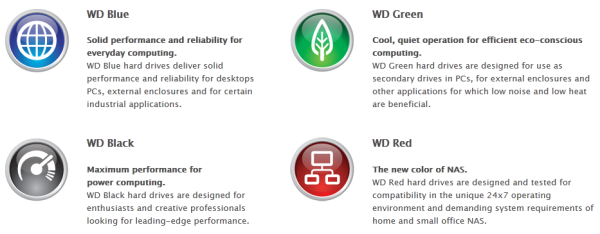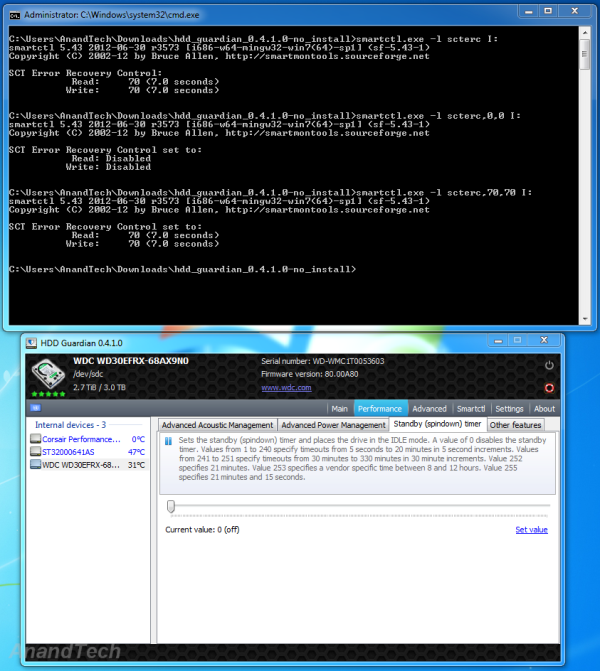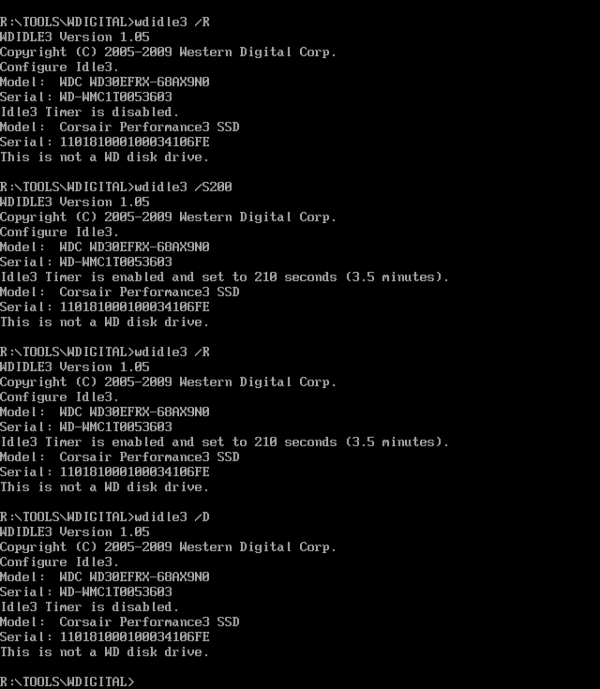Western Digital Red Review: Are NAS-optimized HDDs Worth the Premium?
by Ganesh T S on August 17, 2012 4:20 PM EST- Posted in
- Storage
- NAS
- Western Digital
WD Red Lineup: Differentiating Features
Western Digital has well-defined product categories for each market segment. The WD Black series caters to those requiring a lot of performance without power concerns. The Green series serves the opposite end of the spectrum, where performance is not that much of an issue (secondary drives for PCs / external enclosures), but heat and power could do with some reduction. The Blue series served the middle tier (everyday computing with optimal performance) and the notebook market. However, none of these models are recommended by WD for 24x7 operation (which happens to be an essential requirement for almost all NAS systems). Till now, none of the HDD vendors have anything specific for SMB / SOHO NAS systems. WD aims to capture this segment of the market with the WD Red lineup.
High end enterprise configurations are served by drives rated for stressful conditions (such as Seagate's Constellation and Cheetah lineups, WD's own RE4 and Hitachi's Ultrastar series). These drives commanded a huge price premium that even tempted some IT staff to fill their RAID arrays with consumer hard drives. Unfortunately, most of these temptations have resulted in bad results (particularly if the consumer hard drives have not been properly 'configured' prior to usage). What are the aspects which differentiate these enterprise drives from consumer versions?
SMART Command Transport Error Recovery Control: This feature allows the OS to set a soft time limit for completion of reads and writes. Seagate calls this ERC (Error Recovery Control). Samsung / Hitachi drives term this CCTL (Command Completion Time Limit), while Western Digital gives it the TLER (Time Limited Error Recovery) moniker. In a typical desktop drive, this could be a large number. In case of a bad sector or some other similar issue, the hard disk might keep retrying the access or try to remap the bad sector right away. The OS would remain waiting for the hard disk to deliver its delayed response. In a NAS environment, this delay could prove fatal, with the drive either being dropped or the NAS going into rebuild mode. So, it is essential that the SCT ERC number be set to a duration shorter than what the NAS OS would wait for before declaring the drive dead. Enterprise drives usually allow configuration of this value and set it by default to a low one (because the RAID controller can get hold of or recover the data from the other drives in the NAS).
Vibration Tolerance: NAS systems usually place a large number of drives close together. If vibrations aren't mitigated, it could result in decreased lifespan of the drives. Enterprise drives usually have increased vibration tolerance and also have in-built mechanisms to dampen themselves.
Higher MTBF and Longer Warranties: HDD vendors provide higher Mean Time Between Failures (MTBF) ratings for their enterprise drives and also walk the talk by usually providing longer warranties compared to the desktop drives.
If you are interested in further coverage of these aspects, this page serves as a good starting point. Some studies have shown that there is not much difference between desktop and enterprise hard drives with respect to real-life MTBFs. StorageMojo, in particular, has a number of posts stressing this viewpoint. Assuming that the end user has the data backed up, it is undeniable that the longer warranty period (in which RMA can be processed) is definitely an advantage. It is also likely that if the HDD vendor has enough faith to increase the warranty period, at least some improvements (particularly in the vibration tolerance mechanism) have been done compared to the consumer desktop versions.
Coming back to the WD Red, readers must be wondering how many of the above aspects can be brought to the consumers by WD without eating into their profit margins from the RE4 sales. We first start off with a overview of some of the aspects of the NASware firmware
Intelligent Error Recovery Control: This NASware feature corresponds to the TLER configuration. The value for the soft time limit can be set through smartctl, if the manufacturer allows it. We tried this out on the WD Red drive connected directly to our testbed.
We find that, by default, the soft limit is set to 7s. This means that all the NAS units certified to be compatible with the WD Red drives wait for more than 7s for a transaction to complete before dropping drives or starting a rebuild. The important aspect is that this value is configurable, and can even be completely disabled, as shown in the screenshot above.
Power Management Features: Some hard drives adopt aggressive head parking and disk spindown to save on power. For example, the WD Green drives were guilty of parking the head after just 8 seconds of inactivity. This increases the load cycle count unnecessarily (drives are usually rated for 300K cycles). Disk spindown (or standby) timer is an orthogonal parameter which actually stops the motor and puts the drive in IDLE mode. As the screenshot above shows, the standby timer is off by default, but this value can be altered through HDD Guardian or any other similar software. The head parking parameter is usually accessible through the Advanced Power Management (APM) feature of the hard drive. Unfortunately, HDD Guardian and other HDD tools indicated that there was no APM support in the WD Red. Eventually, we had to resort to running WD's own WDIDLE3 tool in the DOS mode. It turns out that the head parking interval is only accessible through a proprietary command and WD doesn't expose it to external tools.
As the screenshot above shows, head parking is completely disabled by default. It is also possible to set the head parking time limit, and it is sticky through power cycles. For NAS applications, it is better to leave it in the default state of head parking being disabled.
How does the WD Red achieve power optimization? The secret lies in IntelliPower. The WD Red drives spin at 5400 rpm as per the analysis done by the folks at SPCR. It is the combination of these features which allow the WD Reds to balance performance and also reduce power.
3D Active Balance : Vibration Reduction: WD claims that it is the first-to-market with 3D mechanical balancing technology for vibration reduction. This has obvious benefits in terms of decreasing noise and avoiding performance reduction. However, comparative measurements of this feature with the competition is outside the scope of this review.
Some of the other features of the WD Red drives include support for the ATA Streaming Command Set in the firmware. This allows optimal drive buffer management so as to ensure smooth streaming of AV data (particularly when the NAS is acting as a DLNA server). This obviously requires support in the NAS firmware also. In addition, we also have support for the SMART Command Set (SCT). We saw this earlier in this section when using smartctl to get / set the TLER parameters. Note that the SCT doesn't allow altering of the APM parameters for spindown / head parking, as they belong to the non-SMART device settings.













87 Comments
View All Comments
vgray35@hotmail.com - Tuesday, August 21, 2012 - link
This works fine as long as you can control drive temperatures, and minimize excessive thermal cycling. One important element of the RED drives is that they are rated to 70C operating temperature instead of the usual 55C, so these drives are going to be more reliable.It is possible this higher temp capability may trickle down to future cheaper drives making your approach even more viable.
andersenep - Tuesday, August 21, 2012 - link
An 80mm and 120mm fan keep them idling at about 36C (and they are pretty quiet about it) in a relatively cramped case. Even under extreme prolonged load I would be surprised if they ever got over 55C. My thermostat stays at 25C/78F.As for thermal cycling, I admit that I leave the thing running 24/7 which probably costs me a pretty penny over the long haul. I keep meaning to plug it into my killawatt out of curiousity.
I wouldn't mind paying a little extra for the 3 year warranty, but for what these things cost I could buy a couple green hot spares and still come out $150 ahead (using 2TB drives).
For a home NAS, green is the way to go. Just turn off intellipark. If you're leery of all the bad hype with the WD green drives, samsungs cost the same price and I've had good luck with those for about two years as well now. If you are using any sort of mass storage without a reasonable level of redundancy and regular backups you are just asking for trouble.
I was moderately interested when the red line was announced, but I can't see any added benefits that justify the premium price.
vgray35@hotmail.com - Wednesday, August 22, 2012 - link
Your sentiments will be shared by others, thus keeping RED drive volumes low, and this will lead WD to drop prices to where they are supposed to be.Just wait a while and watch.
Hard drives exceeding 45C start to fall off rapidly in terms of cycle life, while the RED drives may perform as well with temps reaching as high as 55C. The RED drives below 45C are likely to last a very long time with load/unload cycles of 600,000 matching Enterprise drives.
quanta - Wednesday, August 22, 2012 - link
It isn't so much the testing methodology is flawed, but the reviewed drive model for the Seagate drive. Seagate has been making 7200rpm Barracuda with 1TB platters (non-XT) for quite some time, yet only the 500GB platter version of Barracuda XT is used in this review. If Barracuda XT must be used for the test, it should be the 3TB version, which has slightly higher density (600GB), or the Seagagte Constellation ES.2 counterpart.quanta - Wednesday, August 22, 2012 - link
Never mind the 2TB claim, the test did use the 3TB drive. But still, the tested Seagate drives have such huge density disadvantage, it's disappointing that Barracuda XT/Constellation ES don't have the new terabyte platter models.stoked - Wednesday, August 22, 2012 - link
Just ordered 14 of these for a Supermicro 24 drive bay chassis. Crossing fingers we won't have any issues with the LSI 2108 controller and these drives.vgray35@hotmail.com - Monday, September 3, 2012 - link
EXCLUSIVE NASWARE TECHNOLOGY.
The secret is in the technology.
WD’s exclusive NASware technology improves NAS storage performance by reducing common hard drive concerns in NAS systems including concerns for things like compatibility, integration, upgrade ability, reliability and cost of ownership that are experienced with a hard drive designed for desktop computers. Our exclusive technology, NASware™, makes WD Red thrive in the demanding small-NAS environment.
NASware Enhanced reliability.
Your NAS systems is always on, a highly reliable drive is essential. With a 35% MTBF improvement over standard desktop drives, the WD Red drive is designed and manufactured to be a more reliable and robust solution.
NASware 3D Active Balance Plus.
Our enhanced dual-plane balance control technology significantly improves overall drive performance and reliability. Hard drives that are not properly balanced may cause excessive vibration and noise in a multidrive system, reduce the hard drive life span, and degrade the performance over time.
================ WD speaks with forked tongue ====================
CAVEAT EMPTOR
So now we have a better balanced drive to reduce noise, vibration and improve drive life cycle. Are we made to believe this requirement of RED drives is only needed in a 24/7 NAS environment? This is rubbish, balanced drives are needed everywhere.
Desktops running for 8 hours every day is certainly ON for a long time and qualifies as 24/7. But is it not also true that unbalanced drives in a desktop will also reduce drive cycle life? So why is it OK to put such unbalanced drives in desktops which are expected to last just as long as NAS systems? Why is it OK to put a lower quality drive in a desktop and insist a better quality drive is needed for NAS.
Pure Crap. Desktop drive cycle life is just as important. Why is it OK to increase the risk of a drive crash on a desktop, while one goes to great pains to reduce this risk on a NAS system?
BALANCED DRIVES ARE NEEDED ON DESKTOPS TOO.
Western Digital is admitting that GREEN and BLUE drives are CRAP and not suitable for desktops, in part because they are not suitably balanced. Or put another way, they have designed the cheaper drives to be less balanced by design, and dictate that desktops will be subjected to higher reliability risks in terms of disk crashes. By their own admission inadequately balanced drives lead to reduced cycle life. In reality there is no difference between NAS and DESKTOPS in terms of needed cycle life, and what is plainly obvious is that RED drives really constitute a MINIMAL quality for desktop too.
MARKETING BROO HA HA - just another fancy term for Corporate lying.
DRIVE BALANCE IN A SINGLE DRIVE SYSTEM IS JUST AS IMPORTANT AS IN A MULTI- DRIVE SYSTEM FOR THE PURPOSES OF IMPROVING DRIVE CYCLE LIFE. Marketing not withstanding.
What we need is a way of measuring drive balance quality in hard drives, and stick it to them when reviewing these hard drives. We need to be able to measure the WOBBLE FACTOR to gain control over drive quality assessments.
Hot_Jane - Thursday, October 11, 2012 - link
If these "red" drives are so much better, and more durable, than their "black" drives... why do the "reds" have a 2 *YEAR* shorter warranty????(anandtech foolishly compares warranties only on the drives that are even LESS than the "reds".)
Casper42 - Wednesday, November 14, 2012 - link
http://www.newegg.com/Product/Product.aspx?Item=N8...Sale today on Red
$149 / 3TB
Limit 3
andrewket - Thursday, November 15, 2012 - link
I followed your link. I'm showing $169/ea. Is there a coupon code I need to use?